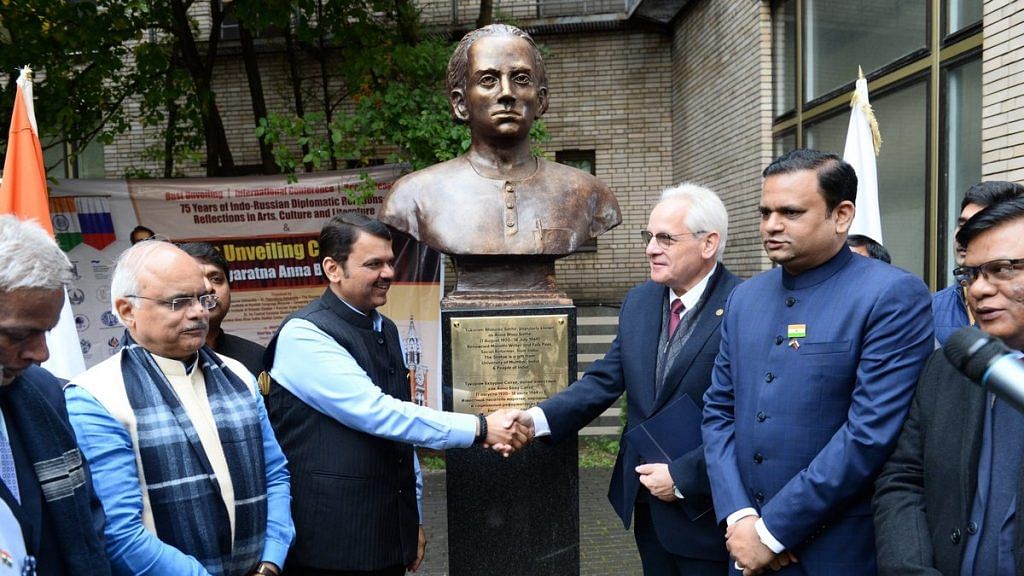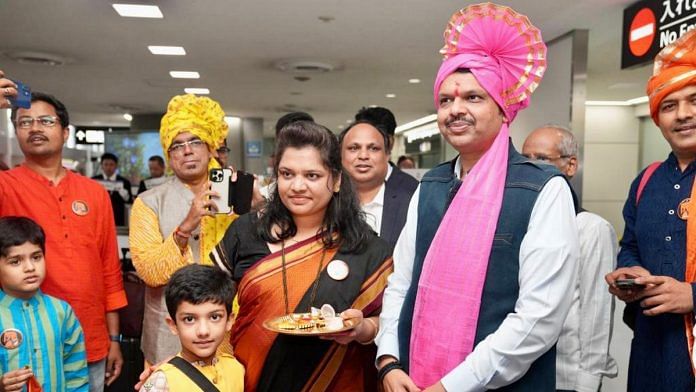Mumbai: For Maharashtra Deputy Chief Minister Devendra Fadnavis, exiting Narita International Airport in Tokyo, in his own words, seemed like “reaching Mumbai or Pune”.
As he stepped out of the airport, he was greeted by a group of Maharashtra-origin Japan residents, many dressed in traditional attire, complete with saffron phetas (turbans). A woman among them greeted the BJP leader with an aukshan, a spiritual welcome involving the waving of a lit lamp, and the group broke into a Marathi song, ‘Laabhale amhas bhagya bolto Marathi (We are fortunate that we speak Marathi)’.
Fadnavis, who also holds the protocol department, shared a video of the warm welcome he got on his X (formerly Twitter) handle.
धन्यवाद जपान तुमच्या प्रेमासाठी! 🙏🏻
Thank you, Japan for your love!
आपके प्यार के लिए धन्यवाद जापान!#MaharashtraInJapan #Japan #Tokyo #IndiaJapan #Historic #Maharashtra #Marathi #IndianCricket pic.twitter.com/hNgqCJvt3H— Devendra Fadnavis (@Dev_Fadnavis) August 21, 2023
He also shared a video compilation of Marathi residents in Japan effusively welcoming him. They said things like Fadnavis has “fans even in Japan”, and that they hoped his five-day visit would strengthen relations between the country and the state of Maharashtra.
Ever since he became Chief Minister in 2014 in the then BJP-Shiv Sena government, Fadnavis has mindfully cultivated a relationship with the Marathi diaspora in different countries through his foreign visits. Analysts say that he is perhaps the first Maharashtra leader after Nationalist Congress Party’s (NCP) Sharad Pawar to do so.
They also add that his focus on the diaspora has especially sharpened over the past 14 months, since he took charge as Deputy CM in the Eknath Shinde-led government.
Speaking to ThePrint, political commentator Hemant Desai said that since the Uddhav Thackeray-led Maha Vikas Aghadi (MVA) government was toppled by Shinde’s rebellion last year, the party has raised its pitch against the BJP as a “Delhi-centric party where all decisions are taken by the high command” in the national capital.
“In this backdrop, increasing interaction and proximity with the Marathi diaspora helps Fadnavis showcase that he is giving true representation to Marathi people,” Desai said.
“It is also a way of creating an image that though he may be Deputy CM, jostling for space with CM Shinde and co-Deputy CM Ajit Pawar, he is still the boss. In comparison, neither Shinde nor Ajit Pawar have this kind of a knack or even the inclination to actively pitch themselves to the Marathi diaspora,” he added.
According to Madhav Bhandari, BJP Maharashtra vice president, Fadnavis is perhaps the first CM who is engaging with the Marathi diaspora “in toto”.
“When Pawar saheb (Sharad Pawar) was interacting with people it was limited to the United States and the United Kingdom and that too, the upper echelons of the society. He did not interact with entire diaspora,” Bhandari told ThePrint
He added: “Marathi people have impressive and impactful presence in many countries. They are in industry, commerce, other business and all these things are beneficial for Maharashtra and not only BJP. Eventually when the government and the state benefits, the party also benefits to a certain extent.”
Also Read: 1 yr of Shinde-Fadnavis govt: Infra push, populist moves, Uddhav-bashing & a 2-man show with rifts
Sathe in Russia, Shivaji in Mauritius
In the last year, Fadnavis has had three foreign visits, including the trip to Japan described above. At every place, he left the Marathi-speaking people he met with the same message— that he is extremely grateful to them for keeping Maharashtra’s language and culture alive and thriving even in a foreign country.
Even at the airport in Japan, speaking to the people gathered to welcome him, Fadnavis said: “People like you have kept the Marathi language, Maharashtra dharma, and the pride of Maharashtra alive across seven seas and for that I express my heartfelt gratitude to you.”
Fadnavis also offered the support of the Maharashtra government to help the Marathi community in Japan celebrate the 350th anniversary of Maratha warrior king Chhatrapati Shivaji’s coronation.
Then, in September last year, Fadnavis visited Russia, where he unveiled a bust of social reformer, poet, and writer Annabhau Sathe at the Margarita Rudomino All-Russian State Library for International Literature. He also dedicated a portrait of Sathe to the Indian embassy in Moscow.

The work of Sathe, known as India’s Maxim Gorky, was heavily inspired by Communist ideology and the Russian revolution.
Fadnavis’s praise for Sathe in Russia as someone “who spoke for the marginalised and the discriminated” also helped pitch the BJP to the entire diaspora, irrespective of political ideology.
Bhandari said visits like these help the BJP take its message to the diaspora directly instead of letting them rely on the messaging that may be coming out of the country.
“We get to show that the BJP is a party that wants to engage with people from across ideologies. The Opposition in India has created an image that the BJP doesn’t want to talk to liberals with a leftist ideology. But, we are always willing to engage. It is they who don’t want to,” he added.
Officials from the Deputy Chief Minister’s office said that Fadnavis interacted with Russia’s Indian community, including many people with Maharashtrian roots. He also met with young people from Maharashtra who are studying in Russia to learn about their challenges and requirements.
Yet another trip taken by Fadnavis was to Mauritius this April, initiated by the Marathi Mandal in the country. The Deputy CM inaugurated a statue of Maratha warrior king Chhatrapati Shivaji there.
While in Mauritius, he also visited the Pandhurang Kshetra Mandir, a Vitthal-Rukmini temple in Cascavelle, and interacted with the Marathi community there.
He wore a crisp navy-blue suit, but made it a point to don the characteristic white cap worn by Warkaris, devotees of Lord Vitthal and Rukmini. With a gandha, or teeka of sandalwood paste, on his forehead, he invoked the saints of the Bhakti tradition before starting his speech.
“After coming here, the purity and the vibe that you get, it feels like we are in Lord Vitthal’s temple in Pandharpur. When I heard the bhajans, I couldn’t remember if I was in Maharashtra or Mauritius,” Fadnavis, speaking in Marathi, said at the temple.
A senior official from the Deputy CM’s team said that Fadnavis made a point of interacting with the Marathi community on his foreign visits even during his tenure as Chief Minister of Maharashtra from 2014 to 2019. The official recalled Fadnavis’s visit to Israel and the United States in 2015, when the then-CM met with many members of the Marathi diaspora.
Political analyst Desai agrees that Fadnavis has always “taken a page out of Prime Minister Narendra Modi’s book” by cultivating a relationship with the regional diaspora. However, Desai noted that the Deputy CM’s efforts have become more “obvious” over his past few visits.
Big ambitions, soft power
Before Fadnavis, political analysts said NCP’s Sharad Pawar frequently travelled to foreign countries and interacted with the Marathi diaspora when he served as Maharashtra’s Chief Minister, first from March 1990 to June 1991, and then again from March 1993 to March 1995.
Political analyst Abhay Deshpande told ThePrint that other CMs in the first decade of the 2000s, including Vilasrao Desmukh, Prithviraj Chavan, and Ashok Chavan, also undertook many foreign tours. “But those were more from the point of view of seeking investments, not for cultural engagements like Fadnavis’s Mauritius or Russia tours,” Deshpande said.
He added that Fadnavis is looking to build his overall image through such interactions, keeping his long-term political ambitions in mind.
“He would like to be a big figure and prove that he has the material needed to be in the race for PM longer term. CM Shinde is not very comfortable with foreign tours, so the pitch is clear for him,” Deshpande said.
An official from Fadnavis’s team said these visits make Maharashtrians living abroad feel that they have some support from back home. A politician from their home state visiting them and speaking to them directly has a different impact, and it also helps to establish political relations, the officials added.
“We get to know of issues that students, entrepreneurs, and people working across sectors are facing. Over a period of time, they can also lobby with their local governments to look at Maharashtra for engagements and interactions,” the official explained. “It’s a slow and ongoing process. The results don’t show overnight.”
According to the United Nations’ International Migration report, 2020, the Indian diaspora is the largest in the world, comprising 18 million persons living in various countries.
Uttara Sahasrabuddhe, former head of the department of politics and civics at Mumbai University, told ThePrint that diaspora represents soft power, the influence of which is not always obvious
“But, the diaspora can be of help…in democratic countries, they form a distinct lobby with some very influential pressure groups. Parties are looking at these pressure groups to influence policy choices that align with them,” she said.
Sahasrabuddhe gave the example of Rahul Gandhi, explaining that when he goes abroad and speaks to the Indian diaspora, his aim is for them to convince their respective governments to support the Congress rather than the BJP. The same, she added, is true for Prime Minister Modi when he interacts with the diaspora.
“Modi had wooed the Gujarati diaspora a lot when he was Gujarat CM. It is not at all surprising that regional leaders are now approaching the regional diaspora,” Sahasrabuddhe said. “The influence, though, is very nuanced.”
(Edited by Asavari Singh)
Also Read: With agitation for Mumbai-Goa highway, Marathi manoos card, Raj Thackeray eyes resurgence via Konkan



